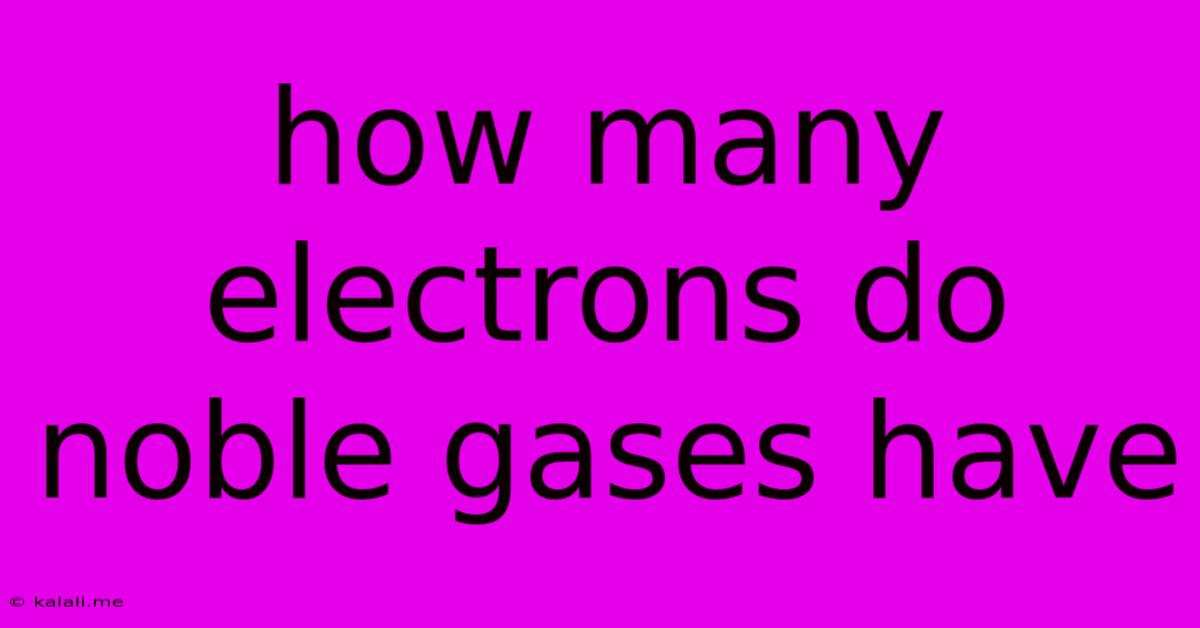How Many Electrons Do Noble Gases Have
Kalali
Jun 13, 2025 · 3 min read

Table of Contents
How Many Electrons Do Noble Gases Have? A Deep Dive into Electron Configurations
Noble gases, also known as inert gases, are a fascinating group of elements found in Group 18 of the periodic table. Their unique chemical properties, largely stemming from their electron configurations, make them incredibly stable and unreactive. This article will explore the electron counts of noble gases and explain why this characteristic contributes to their inert nature. Understanding this will provide a foundational knowledge of chemical bonding and atomic structure.
What makes noble gases unique? Their exceptional stability is due to their complete valence electron shells. This means their outermost electron shell is full, containing the maximum number of electrons it can hold. This full valence shell makes them extremely reluctant to participate in chemical reactions, hence their designation as "inert."
Electron Configuration and the Octet Rule
The number of electrons a noble gas possesses is directly related to its atomic number. The atomic number represents the number of protons in the nucleus and, in a neutral atom, the number of electrons. Let's delve into the electron configurations:
-
Helium (He): Helium, the lightest noble gas, has an atomic number of 2. Its electron configuration is 1s², meaning it has two electrons in its first and only electron shell. While it doesn't follow the octet rule (eight valence electrons), its single shell is completely filled.
-
Neon (Ne): Neon's atomic number is 10. Its electron configuration is 1s²2s²2p⁶, meaning it has ten electrons, with eight electrons in its valence shell (2s²2p⁶). This fulfils the octet rule.
-
Argon (Ar): Argon, with an atomic number of 18, has 18 electrons. Its electron configuration is 1s²2s²2p⁶3s²3p⁶, again displaying a full valence shell of eight electrons (3s²3p⁶).
-
Krypton (Kr): Krypton's atomic number is 36, possessing 36 electrons. Its electron configuration follows a similar pattern, with a complete valence shell.
-
Xenon (Xe): Xenon, atomic number 54, has 54 electrons.
-
Radon (Rn): Radon, atomic number 86, has 86 electrons.
-
Oganesson (Og): Oganesson, a synthetic element, has an atomic number of 118 and thus 118 electrons. While its chemical properties are still under investigation, it's predicted to follow the noble gas trend.
Exceptions and Implications
While the octet rule is a useful guideline, it's important to note that it's not universally applicable. Helium, with only two electrons, showcases a stable configuration despite not having eight valence electrons. This is because its single electron shell is complete.
The stability of noble gases has significant implications in various fields:
- Inert atmospheres: Noble gases are used to create inert atmospheres in industrial processes where reactivity needs to be minimized.
- Lighting: Noble gases are used in lighting applications due to their ability to emit light when electrically excited. Neon lights are a classic example.
- Medical applications: Some noble gases have medical applications, such as MRI contrast agents.
In conclusion, the number of electrons in noble gases directly correlates with their atomic number. Their unique electron configurations, characterized by completely filled valence shells, are responsible for their remarkable inertness and wide range of applications. Understanding this fundamental aspect of atomic structure is crucial for comprehending chemical reactivity and the behavior of matter.
Latest Posts
Latest Posts
-
Unit Weight Of Water At 4 Degrees Celsius
Jun 13, 2025
-
Steam Enters A Well Insulated Turbine
Jun 13, 2025
-
Which Of The Following Statements About Cells Is True
Jun 13, 2025
-
What Gpa Do You Need To Get Into Howard University
Jun 13, 2025
-
What Is The First Step Of The Communication Process
Jun 13, 2025
Related Post
Thank you for visiting our website which covers about How Many Electrons Do Noble Gases Have . We hope the information provided has been useful to you. Feel free to contact us if you have any questions or need further assistance. See you next time and don't miss to bookmark.